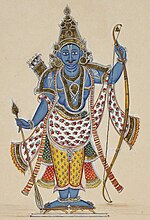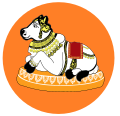Search results
Appearance
There is a page named "Ramanandi Sampradaya" on Wikipedia
- Chaitanya Vaisnava sampradaya)other Vaishnava traditions in Bengal, such as Vaishnava-Sahajiya, Ramanandi Sampradaya, Mahanam Sampraday, and others – but Gaudiya Vaishnavism is described...51 KB (5,749 words) - 04:53, 20 June 2024
- India. The Hindu tradition recognizes him as the founder of the Ramanandi Sampradaya, the largest monastic Hindu renunciant community in modern times...17 KB (1,957 words) - 11:12, 28 May 2024
- Baba was a Ramanandi Hindu saint and disciple of Anantananda, one of the twelve disciple of Ramananda (the founder of Ramanandi Sampradaya). Krishnadas...16 KB (1,462 words) - 11:26, 25 February 2024
- The Swaminarayan Sampradaya, also known as Swaminarayan Hinduism and Swaminarayan movement, is a Hindu Vaishnava sampradaya rooted in Ramanuja's Vishishtadvaita...104 KB (11,827 words) - 20:45, 1 July 2024
- Nageshwar Nath. This shrine is under the charge of Bairagi Mahants of Ramanandi Sampradaya and Nirvani Akhara. Safdarjung and Shuja-ud-daulah, built the temple's...4 KB (378 words) - 03:48, 13 March 2024
- times. As part of the Bhakti movement, Rama became focus of the Ramanandi Sampradaya, a sannyasi community founded by the 14th-century North-Indian poet-saint...115 KB (11,597 words) - 01:10, 2 July 2024
- Vaishnavism (section Ramanandi tradition)or even all of these at various times for various devotees. The Ramanandi Sampradaya, also known as the Ramayats or the Ramavats, is one of the largest...171 KB (17,698 words) - 21:07, 1 July 2024
Ramanandacharya" is used in the lineage of Ramananda, founder of Ramanandi Sampradaya. Kripalu Maharaj (c. 1922 – c. 2013), founder of Jagadguru Kripalu...
9 KB (765 words) - 13:04, 26 March 2024
his spiritual knowledge from Ramananda and was a follower of the Ramanandi Sampradaya tradition. His ideas and fame grew over his lifetime, and texts suggest...
31 KB (3,497 words) - 17:23, 8 June 2024
Pranami/Pranami Sampraday Radha Vallabh Sampradaya Ramsnehi Sampradaya Rudra Sampradaya Pushtimarg Sri Vaishnavism Ramanandi Sampradaya Thenkalais Manavala Mamunigal...
75 KB (5,192 words) - 05:06, 3 July 2024
Sampradaya (Sanskrit: सम्प्रदाय; IAST: Saṃpradāya), in Indian origin religions, namely Hinduism, Buddhism, Jainism, and Sikhism, can be translated as...
46 KB (4,832 words) - 11:39, 27 June 2024
Swami Balanandacharya was a Vaishnav saint of Ramanandi Sampradaya. Balanand said that when a person dies, their soul continues to exist in a disembodied...
2 KB (75 words) - 13:35, 21 February 2024
known as Pandori Dham) is a historical Hindu temple belonging to Ramanandi Sampradaya, located in the village Pandori Mahantan in Gurdaspur district of...
11 KB (1,212 words) - 05:50, 11 January 2024
Vaishnava Sampradaya of southern India Sri Ramanandi Sect of Northern India, it has the largest monastic order in whole India Dāmodariya Vaiśņava sampradaya of...
32 KB (4,280 words) - 06:53, 3 July 2024
entity (sampradaya), that have survived into the modern era, are from the 17th century. Before the 17th century, while a mention of the Nath sampradaya as...
37 KB (4,059 words) - 16:12, 11 June 2024
Kabir Panth, Seunariani (Sieunarini/Siewnaraini/Shiv Narayani), Ramanandi Sampradaya, Aughar (Aghor), Kali Mai (Madrasi), Sathya Sai Baba movement, Shirdi...
174 KB (17,349 words) - 12:32, 1 July 2024
- India. The Hindu tradition recognizes him as the founder of the Ramanandi Sampradaya, the largest monastic Hindu renunciant community in modern times










